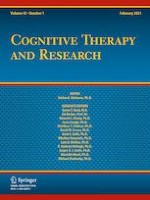13-11-2020 | Brief Report
Change in Attentional Control Predicts Change in Attentional Bias to Negative Information in Response to Elevated State Anxiety
Gepubliceerd in: Cognitive Therapy and Research | Uitgave 1/2021
Log in om toegang te krijgenAbstract
Background
Researchers have demonstrated that elevation in state anxiety leads to elevation in attentional bias favouring the processing of negative information, and that the magnitude of this attentional bias change varies across individuals. However, research has not identified the mechanisms that underpin individual variation in state-anxiety induced attentional bias change. Researchers have also demonstrated that inhibitory control of attention becomes impaired when state anxiety is elevated, and cognitive models propose that impaired inhibitory control of attention may underpin attentional bias to negative information. Thus, the present study investigated whether individual differences in the magnitude of attentional bias elevation elicited by heightened state anxiety is predicted by the degree to which such state anxiety elevation impairs attentional control.
Methods
Eighty participants completed assessments of attentional bias to negative information and inhibitory control of attention prior to, and following, a procedure designed to elevate state anxiety.
Results
It was observed that greater elevation in attentional bias to negative information was predicted by lesser decline in inhibitory control of attention as state anxiety increased.
Conclusions
Findings support proposal of a relationship between attentional control and attentional bias to negative information, though are inconsistent with the proposal that heightened attentional bias to negative information is uniformly underpinned by greater impairment in attentional control. Implications are discussed.
